使用理论计算和实验将 Bi 掺杂到氮化硼纳米片中对电子和光学性能的影响
摘要
在目前的工作中,氮化硼 (BN) 纳米片是通过体相 BN 液相剥离制备的,同时各种重量。使用水热技术将比例 (2.5、5、7.5 和 10) 的铋 (Bi) 作为掺杂剂掺入。我们的研究结果表明,光学研究显示近紫外区域的吸收光谱。密度泛函理论计算表明,Bi 掺杂通过在费米能级周围引入新的局部间隙态,导致 BN 纳米片的电子结构发生各种变化。发现带隙能量随着Bi掺杂浓度的增加而降低。因此,在对计算吸收光谱的分析中,在吸收边缘处观察到红移,这与实验观察一致。此外,还评估了主体和 Bi 掺杂的 BN 纳米片的催化和抗菌潜力。通过评估它们在染料还原/降解过程中的性能来评估游离和掺杂的 BN 纳米片的催化活性。 Bi掺杂的BN纳米片的杀菌活性导致对S的杀菌效率提高了0-33.8%和43.4-60%。金黄色葡萄球菌 和 0-38.8% 和 50.5-85.8% 对抗 E。大肠杆菌 , 分别。此外,计算机分子对接预测与体外杀菌活性非常一致。双掺杂的 BN 纳米片对 E 的 DHFR 显示出良好的结合分数。大肠杆菌 (- 11.971 kcal/mol) 和 S。金黄色葡萄球菌 (- 8.526 kcal/mol) 同时对来自 E. 的 DNA 促旋酶的结合评分。大肠杆菌 (- 6.782 kcal/mol) 和 S。金黄色葡萄球菌 (- 7.819 kcal/mol) 表明这些选定的酶是可能的目标。
介绍
各种化学品、有机化合物和工业废物造成环境污染,对人类、动物和水生生物造成严重后果 [1, 2]。由于这个原因,对创新和环保的废水处理技术的需求不断增长 [3, 4]。每年有数百万人因受污染的水而丧生 [5, 6]。几乎每年工业部门的染料利用率为 ~ 10,000;其中,一个突出的来源是在大气和水生生物中使用 10-15% 的亚甲蓝 (MB) [7,8,9,10]。 MB 是一种简单的苯胺染料,分子式为 C16H18N3SCl,广泛用于棉、羊毛和丝绸的染色以及治疗高铁血红蛋白血症和氰化物中毒。生物学家使用它对组织样本进行染色并检测核酸。无论如何,这种染料对人类和野生动物都有许多负面影响。因此,去除排水中的染料对人类和水生生物的福利很重要[11, 12]。
用于去除水中各种污染物的常规方法包括沉淀、电解、絮凝、光催化、膜过滤、离子交换、吸附、反渗透和生物处理 [13, 14]。在这些方法中,催化活性 (CA) 因其具有成本效益和环境可持续的方法而被广泛使用 [15]。 CA由还原剂和纳米催化剂组成,制备的样品是降解MB等合成染料的样品[16,17,18]。
对净化废水的要求不断提高,导致开发和使用一类新的纳米材料,称为二维材料 (2D-Mats)。石墨烯的发现促进了这些材料的利用 [19,20,21]。目前,已经合成了多种 2D-Mats,包括二硫化钼 (MoS2) 和 MXene (Dirac 2D-Mats) [22, 23]。氮化硼被认为是一种很有前途的 MXene 类 [24, 25]。 BN 纳米片具有多种有趣的特性,包括介电性能、化学和热稳定性、深紫外线和直接带隙能量,使其适用于各种应用,尤其是水处理和抗菌活性 [24, 26, 27]。为了说明这些任务,富含铋的策略或掺杂不同的过渡金属元素(即 Bi)是最容易获得的方法。与其他颜色相比,Bi 具有非凡的外观,呈灰白色,带微红色(粉红色斑点)。 Bi 形成氧化态为 + 3 和 + 5 的化合物。Bi 化合物用作废水处理的纳米催化剂,并且当它在 2D-Mat(例如 BN)中用作掺杂剂时,它也是一种很好的抗菌剂,如上文所讨论的 [28, 29,30,31]。
除上述之外,BN 纳米片还可以在生物医学领域用作抗菌剂,以防止各种细菌 [32]。乳腺炎的特点是乳房实质组织的物理化学和病理生物学改变,在世界范围内具有直接的经济影响。由于乳糜泻,人类极易患上人畜共患病,例如钩端螺旋体病、链球菌性喉咙痛、布鲁氏菌病和肺结核[33]。通常,涉及细菌和病毒的传染性病原体分为两类。第一类包括金黄色葡萄球菌 (金黄色葡萄球菌 ), 大肠菌 , 棒状杆菌 , 链球菌 和大肠杆菌(E.coli) .第二类包括牛棒状杆菌 和凝固酶阴性葡萄球菌 [2, 32, 34, 35]。其中,较为突出的是耐甲氧西林金黄色葡萄球菌 (MRSA),因为它导致全球大量死亡。革兰氏阳性和革兰氏阴性病原菌对抗生素产生耐药性,对人类健康构成严重威胁[36]。此外,由 E. 的存在引起的腹泻疾病。大肠杆菌 水中的细菌导致每年 130 万 5 岁以下儿童死亡。作为一种抗菌剂,BN 可以保护免受这些有害病原体的侵害 [37]。由于Bi的生物相容性,以Bi盐、NPs和纳米材料等各种形式合成和使用Bi作为抗菌剂受到了极大的关注[38]。由幽门螺杆菌 (H. pylori) 引起的感染目前使用 Bi 有机盐和抗生素的混合物进行治疗 [39, 40]。纳米结构产生的氧化应激取决于其大小;由于小尺寸纳米结构产生活性氧 (ROS),活性氧 (ROS) 在植入物内的细菌膜内更有效地结合,从而导致细胞质内容物的挤出并破坏细菌 DNA、蛋白质和酶 [41,42,43]。除了产生 ROS 外,纳米结构与带负电荷的细菌细胞膜部分的强阳离子界面在高浓度下具有优异的杀菌活性,促进细菌细胞崩溃 [44, 45]。
在本研究中,使用化学剥离技术制备 BN 纳米片,同时使用水热技术将铋 (Bi) 作为掺杂剂掺入。合成材料的 CA 是根据有害 MB 的减少来确定的。此外,针对大肠杆菌评估了抗菌活性。大肠杆菌 和S。金黄色葡萄球菌。 为确定可能的作用机制,针对来自叶酸生物合成途径的二氢叶酸还原酶 (DHFR) 以及来自属于 E.大肠杆菌 和S。金黄色葡萄球菌 .利用第一性原理密度泛函理论计算了原始和Bi掺杂BN纳米片的稳定性结构、电子和光学性质。
方法
本研究通过理论计算和实验研究Bi掺杂BN纳米片对电子和光学性能的影响:染料降解、抗菌行为和分子对接分析。
实验细节
BN 散装粉末 (98%)、二甲基甲酰胺 (DMF) 购自德国 Sigma-Aldrich。五水氮化铋 Bi(NO3)3·5H2O (98%) 来自 BDH 实验室供应英国普尔。所有收到的化学品均未经纯化处理而直接使用。
为了生产 BN 纳米片,对块状 BN 进行液相剥离。将 200mg 大块 BN 粉末溶解在 DMF (50ml) 中并搅拌 15 分钟。随后,溶解的溶液在 50°C 下超声处理 12 小时,如图 1a 所示。将该超声悬浮液以 3500 rpm 的速度离心 20 分钟 [46]。使用水热法使用五水氮化铋 Bi(NO3)3·5H2O 作为 Bi 的来源,用 Bi 掺杂收集的纳米片。将各种 Bi 掺杂剂浓度(2.5、5、7.5 和 10 wt%)以固定比例(0.025:1、0.05:1、0.075:1 和 0.1:1)分别添加到聚四氟乙烯容器中并转移到高压釜中如图 1b 所示,在 200°C 下放置 12 小时。之后,高压釜冷却,所得产物用乙醇、去离子水等清洗剂反复洗涤除去杂质,溶液在真空烘箱中100℃干燥。
<图片>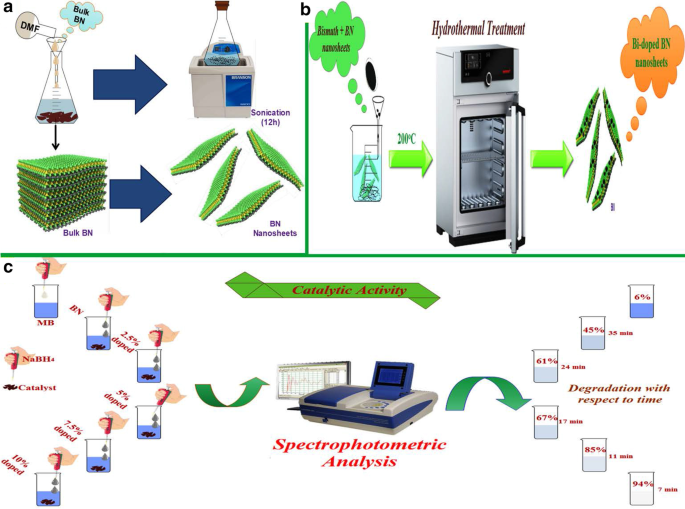
a 的示意图 大块BN的液相剥离; b 水热合成; c 催化活性
范德华引力是大块氮化硼堆叠层之间的主要作用力。必须克服这些范德瓦尔斯相互作用才能剥离堆叠层。这是通过将有机溶剂插入层中,然后引入从超浴超声仪获得的机械力来进行的。表面张力与氮化硼相匹配的溶剂是散装氮化硼良好分散的理想溶剂,因为它们可以最大限度地减少溶剂和氮化硼之间的界面张力。这就是我们采用 DMF 的原因,因为它的表面张力与石墨烯 (37.1 m J m −2 ),BN类似于石墨烯,是一种非常适合分散氮化硼纳米片的溶剂[47]。
超声波辐射穿过介质,溶剂分子压缩和拉伸,即开始围绕它们的平均位置振荡,导致高压区的发展,可以称为压缩,负压区称为拉伸。当负压不足以保持液体分子完整时,液体就会发生分解,形成空隙(空化气泡)。这些空化气泡在高压区会剧烈崩溃,表现为微反应器,产生几千度的局部温度和几百个大气压的高压,足以克服片间吸引力,从而引起剥落[48, 49] .
催化活动
通过在作为还原剂的硼氢化钠 (NaBH4) 存在下进行 MB 染料降解来评估催化潜力。首先,将适量的染料和还原剂用去离子水稀释,制成水溶液。利用所有制备的样品作为纳米催化剂进行催化实验。通过将 NaBH4 溶液 (600 μl) 添加到石英池中的 MB (10 μl) 来测量染料降解。这里值得一提的是,NaBH4 不能降解染料,因此它仅用作还原剂。此外,将每种催化剂 (4 mg) 分别添加到前体溶液中,以研究染料降解的催化效率。通过使用紫外-可见分光光度计在 450-750 nm 范围内获取吸收光谱来测量染料的还原。在这方面,亚甲蓝的脱色被认为是染料降解成功的标志。图 1c 显示了用纯 BN 和各种掺杂浓度进行的活性的示意图。左边的插图表示进行的活动,而右边的插图表示用紫外-可见光谱仪获取吸收光谱后时间的降解浓度。
抗菌活性
Bi掺杂BNNS的抗菌潜力的体外评估是通过擦拭1.5 × 10 8 的井扩散法完成的 MSA 和 MA 上 G+ve 和 –ve 细菌分离物的 CFU/mL,分别如附加文件 1:图 S1 所示。在 MSA 和 MA 板上的孔 (6 mm) 中以低和高剂量接种各种比例的 Bi 掺杂 BNNS (500 μg/50 μl) 和 (1000 μg/50 μl) 附加文件 1:图 S1。环丙沙星 (5 μg/50 μl) 和 DIW (50 μl) 被标记为阳性 (+ve) 和阴性 (-ve) 对照。在 37°C 下培养培养皿过夜后,使用游标卡尺测量抑菌圈 (mm) 来证明抗菌评估 [50]
材料表征
来自 Bruker (D2 Phaser, USA) 的 X 射线衍射仪 (XRD),配备有 Cu-K\(\alpha\) (λ =0.154 nm) 的衍射角 (2θ) 范围从 10° 到 60°,扫描速率为 0.05/min,以确定合成材料的结构特征。傅里叶变换红外 (FTIR) 光谱(珀金埃尔默光谱仪),波数精度在 ± 0.01 cm -1 被用来勾勒红外指纹。使用 GENESYS-10S UV-Vis 评估光学特性,扫描速率为 5 nm/s,吸收光谱范围为 200-800 nm,并使用 JASCO FP-8200 分光荧光计进行光致发光研究,扫描速率为 10 nm/s。使用场发射扫描电子显微镜(FESEM model JSM 6460LV)结合能量色散X射线(EDS)光谱仪和JEOL JEM 2100F高分辨率透射电子显微镜(HR-TEM)研究表面形貌和微观结构。
计算细节
我们的第一性原理计算是通过在 QuantumATK 软件 [51] 中使用原子轨道 (LCAO) 方法的局部组合实现的 DFT 的综合框架进行的。交换相关泛函由 Perdew、Burke、Ernzerhof (PBE) 与广义梯度近似 (GGA) 结合 [52] 进行。使用范数守恒 PseudoDojo [53] 赝势来描述电子和离子之间的相互作用,以及价电子 布里渊区采用 Monkhorst–Pack 的特殊 k 点网格 4 × 4 × 1 进行结构弛豫和 7 × 7 × 1 用于电子性质计算。自洽场 (SCF) 的计算考虑了 10 -6 哈为能量收敛。几何结构和离子弛豫是通过使用有限内存的 Broyden-Fletcher-Goldfarb-Shanno (LBFGS) 算法进行的,包括每个原子上的力小于 0.05 eV/Å。由于重Bi掺杂剂的存在会产生强相对论效应,因此在计算电子结构时考虑了自旋轨道耦合(SOC)的贡献。
结果与讨论
结构和电子属性
如图 2a 所示,XRD 用于研究对照和 Bi 掺杂的 BN 纳米片的相识别、结晶度和晶面。在 ~ 26.9°、41.3°、43.46°和50.2°的2θ值处确定的XRD反射分别被标记为(002)、(100)、(101)和(102)晶面。检测到的晶面与标准光谱(JCPDS 参考号 #00-034-0421)[54, 55] 协调得很好。锐度和峰值强度表明 BN 薄层的形成和 NS 在优选 c 方向的弱堆叠 [46]。在 XRD 反射中检测到与衍射角有关的峰位移,这表明掺入了掺杂剂。层间距 (d -value) 的特征 (d 002) 反射被发现 ~ 0.34 nm,通过布拉格定律评估\((n\lambda =2d\mathrm{sin}\theta)\) 并且与 HR-TEM 结果很好地相关(参见附加文件 1:图 S4)。相应平面的 d 值具有与 BN 的吸附特性和分子传输有关的显着特征,可提高其催化性能 [56]。图 2b 中表示的裸 BN 的相应 SAED 轮廓由明亮的圆环组成,表明样品的高结晶度。这些检测到的环与 XRD 图案和标准数据非常吻合 [26, 57, 58]。使用 FESEM 探索合成材料的表面形态,并通过 HR-TEM 分析进一步证实。使用 HR-TEM 图像使用 Gatan 数字显微照片软件评估层间距,发现其与 XRD 结果一致。如附加文件 1:图 1 所示,通过 EDS 光谱分析元素组成来确定所制备产品的纯度。 S5和S6。
<图片>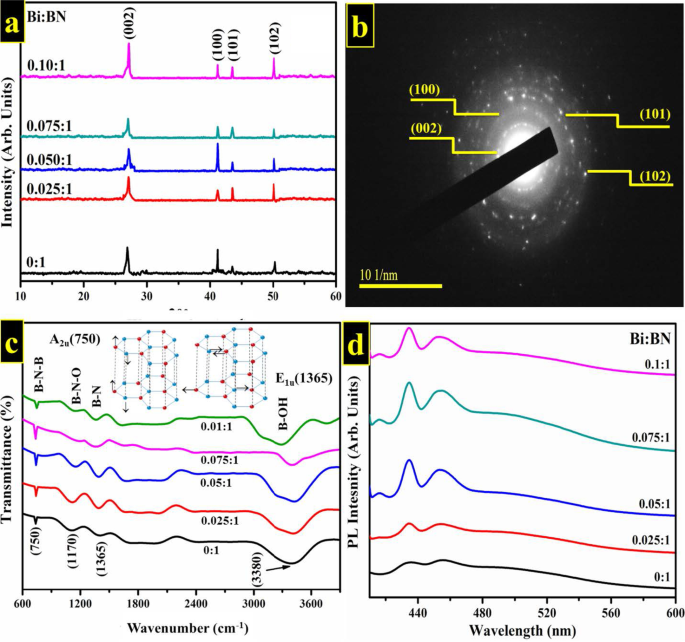
一 不同浓度(2.5、5、7.5和10wt%)的主体和掺杂Bi的BN纳米片的XRD图谱; b 从 BN 纳米片获得的 SAED 图案; c 红外光谱; d PL光谱
FTIR 用于研究主体和 Bi 掺杂的 BN 纳米片的红外指纹,如图 2c 所示。获得的光谱显示了在 750 和 1365 cm -1 处源自 BN 的两个特征峰 可以归因于 B–N–B(弯曲振动)和 B–N(拉伸振动)。这些核心峰值与 A2u 模式(面外)以及 E1u 模式(面内)有关 [56, 59]。如前所述,A2u 模式是一种面外模式,对应于 96.4 meV 的能量,而 E1u 对应于面内模式,该模式进一步分为两种模式,第一个是 E1u TO 其次是横向光学 E1u LO 由于 Michel 和 Verberck [60] 指出的长程库仑相互作用,它们的能量分别为 169.4 和 199.6 meV。在他们的工作中,他们分别比较了在没有和有长程库仑力的情况下计算的两种声子色散关系。两个计算之间的变化对应于 LO-TO 分裂。由于库仑相互作用打破了 BN 中的对称场,导致纵向和横向光学声子的分裂 [61]。这些模式的示意图如图 2c 所示。在 1170 cm -1 处检测到一个额外的峰 与氧氮化硼 (N-B-O) 的伸缩振动有关。 3433 cm −1 处的宽带 对应于O-H伸缩振动[62]。
PL 光谱用于确认样品中的激子迁移、转移和重组,如图 2d 所示。提取的光谱用激发波长标记,即λ ex =390 nm 和相应的发射波长 λ em =420 nm。由于纳米材料对激发波长相对敏感,发射光谱基于λ的值 例如 [59]。未掺杂和掺杂 Bi 的 BN 纳米片的 PL 光谱显示位于 ~ 420 nm 以后的不对称峰。这些在 PL 光谱中检测到的不对称峰表明存在发光物质和/或多荧光团。文献研究表明,硼氧等物质的存在被认为是 BN 系统中的新型发光中心 [63]。在 460 nm 附近发现的发光代表电子跃迁开始。这种电子跃迁涉及位于 BN 带的 2p 状态之间的单独/相互跃迁 [64]。电子的激发 (e − ) 从价带到导带用于增强激发光的发光强度和能量。 460 nm 处的这种跃迁对应于 ~ 2.7 eV [65] 处的能量峰值。值得一提的是,样品是通过相同的数量、生长速率以及持续时间等制备的,但所有样品的 PL 光谱强度略有不同可能是由于单位面积的 h-BN 域较少部分发光[66]。激子的最大复合和分离分别对应于PL光谱中的最高和最低强度峰[67]。
通过使用 UV-Vis 光谱获得的吸收光谱确定主体 BN 和 Bi 掺杂的 BN 纳米片的光学性质。如图 3a 所示,在近紫外区域观察到吸收的出现。纯 BN 纳米片的最大吸收在 200 nm 附近检测到,这被称为近紫外区域,对应于 ~ 5.85 eV 的带隙能量。随着 Bi 的加入,最大吸收边缘向更高的波长移动,这表明光谱中的红移导致带隙能量降低。带隙能量是使用 Tauc 方程估计的,该方程在方程中表示。 1. 图 3b 中显示的 Tauc 曲线表示带隙能量降低至 4.65 eV。除此之外,对于纯的、2.5% 和 5% 的 Bi 掺杂样品,没有检测到对更低或更高能级的额外吸收,这表明存在致密的结构缺陷。而对于 7.5% 和 10% 的 Bi 掺杂样品,在 330 附近观察到非常小的吸收,这也在模拟光学吸收光谱分析中得到验证和解释(见图 6)[62, 68, 69]。根据文献,块状 BN 的带隙能量为 5.2-5.4 eV,而双层/多层纳米片的带隙能量为 5.56-5.92 eV [26]。这些观察结果表明,所制备的 BN 纳米片具有双层/多层结构。图 3b 中显示的所有样品的带隙能量并通过 Tauc 方程估计。 (1)表示如下:
$$\alpha h\nu ={K\left(h\nu - {E}_{g}\right)}^{n}$$ (1)在上面的等式中,α 表示吸收系数等于 \(\alpha =\mathrm{log}(T/d)\) 其中 T 是传输和 d 是路径长度。此外,指数值 (n ) 与 E 的电子性质有关 g 和 分别对应于直接允许转换 (1/2)、间接允许转换 (2)、直接禁止转换 (3/2) 和间接禁止转换 (3)。然而,如果 n =1/2。 E g 通过评估 (αhν ) 1/n vs hν 图。从方程获得的线性趋势。 1 被建模为最大斜率区域附近点的图的切线。这里,hν 等于光子能量 (E ), K 是吸收指数和 E g 是带隙能量 (eV) [26]。
<图片>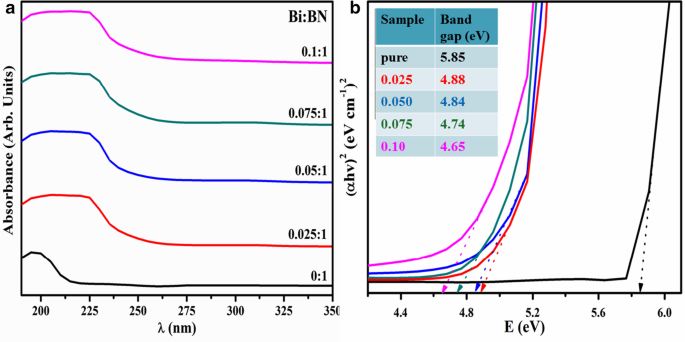
一 主体和Bi掺杂的BN纳米片的UV-Vis光谱; b 基于 Tauc 图的带隙能量分析
这些实验结果得到了基于第一原理的 DFT 计算的支持。使用具有周期性边界条件的超晶胞方法建立未掺杂和掺杂 Bi 单层的模型。 7 × 7 超晶胞用于原始和 Bi 掺杂的 BN 单层,以确保 Bi 与其相邻图像的相互作用最小。沿垂直于单层平面的方向使用 15 埃真空层。 2.04%、4.08% 和 6.1% 的掺杂剂浓度已通过在 B 位点的 BN 单层超晶胞中替换一个、两个和三个 Bi 原子来建模,如附加文件 1:图 S6 所示。为了检验不同浓度的 Bi 掺杂剂的稳定性,我们使用以下等式 [70, 71] 估计了结合能:
$${E}_{\mathrm{b}}={E}_{\mathrm{supercell}}-{E}_{\mathrm{V}}-{E}_{\mathrm{TM}}$ $ (2)其中,E 超胞,E V, 和 E TM 是指掺杂的 BN、具有阳离子空位的主体材料和孤立的金属原子的总能量。发现E的值 b 对于不同的掺杂浓度,从 -4.0 到 - 7.71 eV 变化很大。
为了探索 Bi 掺杂剂对电子结构变化和光学行为的影响,我们通过包括不同浓度的 Bi 掺杂 BN 单层以及原始 BN 的 SOC 贡献来计算电子能带结构和态密度(DOS)单层进行比较,如图所示。 5 和 6。可以看出,原始 BN 在 K 点具有 4.69 eV 的直接带隙能量,如图 4a 所示,与实测实验值 (5.85 eV) 更加一致。此外,我们计算出的带隙能量值与之前的理论工作非常吻合 [72, 73]。该带隙能量值表明 BN 单层是绝缘体。根据图 5a 原始样品的 DOS 曲线,价带最大值主要以 N 2p 为特征 而导带的最小值主要由未占据的 B 2p 控制 状态。当引入掺杂水平为 2.04% 的 Bi 掺杂剂时,在费米能级周围形成了两个新的局部间隙态,如图 4b 所示,其中下能带被占据,而上能带未被占据。因此,价带最大值已移至价带中的较低处,从而降低了带隙能量。此外,价带最大值和导带最小值的主要特征与纯BN单层相似。杂质带的出现将带隙能量分成宽度为 3.39、1.83 和 0.643 eV 的三个子能隙区域。部分 DOSs 分析(见图 5b)表明占据的间隙状态主要由 Bi 6s 构成 与 N 2p 混合的状态 状态,而未占据的间隙状态主要是由于 Bi 6p N 2p 贡献小的状态 状态。在两个 Bi 原子掺杂到 BN 单层的情况下,能带结构呈现出相对较大的导带向下偏移。注意到掺杂带的数量增加导致带隙能量进一步降低。结果是Bi掺杂的BN单层表现出n型半导体的典型特征。从图 4c 可以看出,在费米能级周围引入了四种间隙态。最低的两个掺杂能级被占据并位于费米能级下方约 0.57 和 0.21 eV。其他两能隙状态未被占据,位于费米能级上方 0.40 和 0.80 eV。然而,图 5c 中的 PDOS 显示了 Bi 6s 之间的大部分杂交 和 N 2p 两个小峰的状态和 Bi 6p 的巨大贡献 N 2p 贡献很小的状态 两个高峰的状态。随着 Bi 的掺杂浓度增加到 6.1%,可以观察到在费米能级周围引入了更多的杂质态,并减小了禁带宽度,如图 4d 所示。具有较低能隙态的杂质带出现在 0.36 eV,而具有较高能隙态的杂质带位于费米能级上方 0.61 eV。从部分 DOS 的图(见图 5d)可以看出,对于 6.1% 浓度的 BN 中的 Bi 掺杂,费米能级下方和上方的杂质带的主要特征与 Bi 掺杂的 BN 相似与 x =4.08%,在费米能级之下和之上的杂质带之间有一些重叠。
<图片>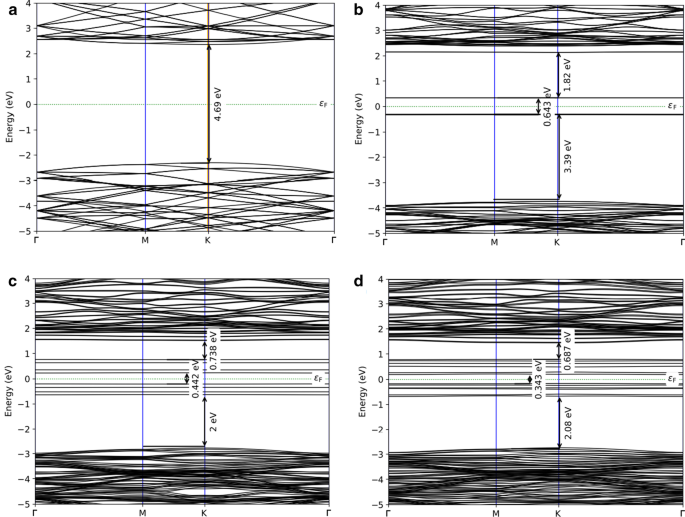
a的计算电子能带结构 具有浓度 b 的原始 BN 和 Bi 掺杂单层 2.04%,c 4.08% 和 d 6.1% <图片>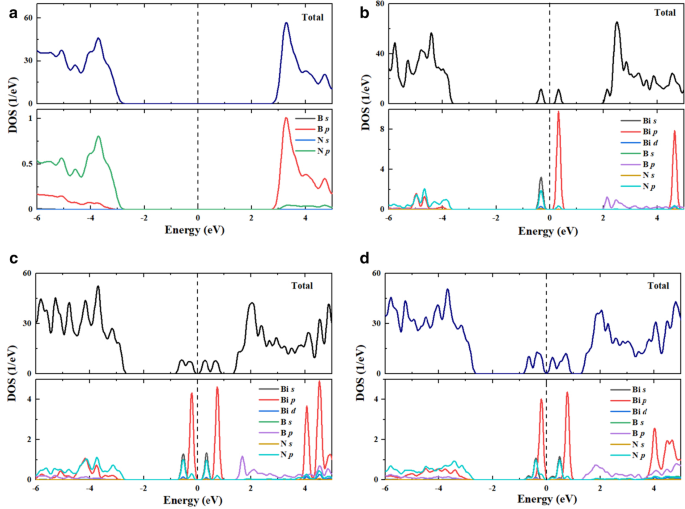
a 的计算总和预计 DOS 原始 BN 和 Bi 掺杂的 BN 单层浓度,b 2.04%,c 4.08% 和 d) 6.1%
计算原始和掺杂 Bi BN 单层的吸收系数并绘制在图 6 中。可以观察到随着 Bi 掺杂浓度的增加,吸收边缘发生红移。在 2.04% 的 Bi 掺杂剂浓度下,与原始 BN 单层相比,吸收边缘显示出约 10 nm 的红移。这种小的红移可能是由于带隙能量的轻微下降而出现的,并且与将 Bi 掺杂到 BN 纳米片中的 20 nm 实验测量红移相当一致。当 Bi 掺入浓度上升到 4.08% 和 6.10% 时,与未掺杂的 BN 单层相比,主吸收边在 22 nm 和 40 nm 处具有更大的红移。这也是由于带隙能量变窄导致重现实验观察结果(见图 3a)。可以观察到,随着 Bi 掺入浓度的增加,在 330 nm 附近出现了另一个非常小的吸收峰。进一步使Bi掺杂BN单层的吸收边红移至345 nm波长值(或3.60 eV能量),表明催化能力增强。
<图片>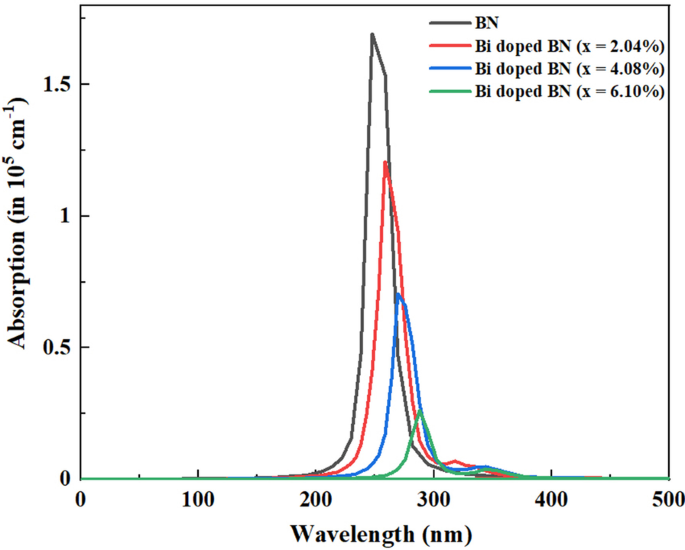
纯和掺Bi BN单层的模拟光吸收光谱
催化活动
评估合成材料催化活性性能的实验结果通过使用时间相关的 UV-Vis 光谱来表示。据观察,将还原剂掺入染料水溶液中并不能将其降解,因为仅实现了 ~ 7% 的染料还原。添加Bi掺杂到BN纳米片(纳米催化剂)中,有效提高了降解百分比。 Pure BN nanosheets display 45% dye reduction in 35 min while BN doped with various concentrations (2.5, 5, 7.5, and 10 wt%) of Bi exhibit enhanced dye reduction with rapid progress.
In general, catalyst lowers the activation energy of a reaction which in turn causes to accelerate its stability and rate of reaction. MB is primarily a synthetic dye that is exploited into water during various industrial processes. MB can be reduced in the presence of reductant however the reduction process is relatively slow in the presence of only NaBH4. Host BN nanosheets exhibit large specific surface area causes to increase adsorption rate. Furthermore, a layer of reductant dispersed over nanocatalysts may also accelerate adsorption due to the redox reaction between catalyst and MB. Reduction reaction by a catalyst occurs by transferring an electron from donor species BH4− (from NaBH4) to acceptor species MB facilitated by pure and Bi-doped BN nanosheets. This resulted to reduce activation energy which serves to stabilize and accelerate rate of the reaction [26, 74]. The mechanism of catalytic activity has been represented in Additional file 1:Fig. S7b. Dye degradation of various doped concentrations (2.5, 5, 7.5 and 10 wt%) was 61, 67, 85 and 94% in 24, 17, 11 and 7 min, respectively as illustrated in Fig. 7. The comparison of present experiment with literature is represented in Table 1.
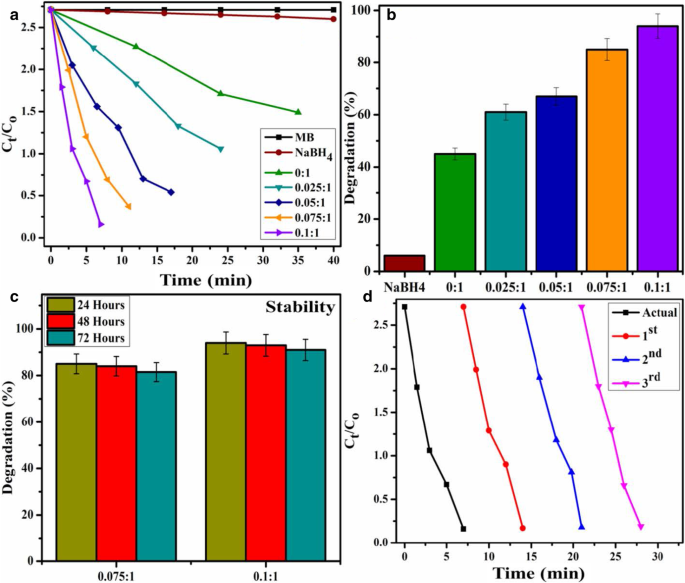
一 Plots of C t /C o versus time for all catalysts; b comparison of degradation percentage over various concentrations, c comparison of stability for 7.5 and 10 wt% Bi-doped catalyst; d plot of C t /C o versus time for reusability of 10 wt% Bi-doped BN catalyst
Increase in the efficiency of catalytic activity is due to an increase in Bi concentration. As degradation percentage directly corresponds to the transfer of electrons from reducing agent towards MB which is facilitated by nanocatalyst. Bi-doped BN nanosheets cause to boost up the reaction rate by lowering its activation energy that in turn causes to facilitate transfer of electron more rapidly towards MB. Plot of C t /C o as a function of time represents dye reduction of all samples as illustrated in Fig. 7a where C t represents concentration of MB at any given time while C o corresponds to initial concentration. Figure 9b exhibits degradation percentage of catalysts which was estimated through Eq. 3.
$$\mathrm{Degradation }(\mathrm{\%}) =\frac{Co-Ct}{Co}\times 100$$ (3)Various factors that influence catalytic activity and affect the performance of catalysts are discussed below.
pH Value
In catalysis (catalytic activity), rate of reaction has a strong correlation with pH value. In general, an extremely low or high value of pH cannot contribute to dye degradation. Literature studies of catalytic activity using reducing agents demonstrate that rate of reaction at basic conditions is most favorable for maximum degradation. In the present study, the pH value at which the maximum degradation was attained was 8.4, which favorably correlates with literature cited. Further, materials such as BN nanosheets controls surface charge and dominate the possible electrostatic interaction between pollutant and material. Therefore, pH value of solution has direct linkage with removal process of pollutants by means of controlling the possible electrostatic interaction between the pollutant and adsorbent [74, 75].
Stability
The stability of catalyst was investigated in the present study by allowing performed experiment to stay for at least three days in order to examine whether the reduction of dye as performed in the presence of nanocatalyst is stable or not. In this regard degraded dye was kept in dark and after every 24 h, degradation was inspected with the help of absorption spectra acquired through UV–Vis spectrophotometer, as illustrated in Fig. 7c. Obtained results indicate that no loss of degradation occurred in stay condition for 72 h. Degradation was observed to be in its fairly original form which affirms the stability of catalyst.
Reusability
Reusability of catalyst refers to recycling ability of catalyst that permits its use more than once. Typically, catalysts with the most number of reusable cycles are considered the most efficient catalyst. In the current experiment, reusability was probed by recycling 10 wt% catalyst up to three cycles. The obtained results are presented in Fig. 7d, which indicates Bi-doped BN catalyst can be utilized as an effective reusable catalyst.
Load of Catalyst
Lastly, load of catalyst before the experiment and after three times of recycling was found. Load of catalyst before performing activity was 4 mg, after three times recycling it was measured as 3.7 mg, considering 5% sensing/detecting deviation. The results indicated that Bi-doped BN acts as the most stable, reusable, and the most efficient dye degrading catalyst. Furthermore, a load of catalyst after three days stability test was also performed that indicate almost same result (3.6 mg) as performed after recycling process.
Bactericidal Activity
In-vitro bactericidal activity of BN, Bi2O3, and Bi-doped BN nanosheets for Gram + ve and Gram –ve bacteria are shown with graphical presentations in Figs. 8 and 9 (a–n). The findings indicate superior bactericidal action with synergism of Bi-doped BN nanosheets against E.大肠杆菌 compared with S.金黄色葡萄球菌 as shown in Figs. 8 and 9 (a–j). BN and Bi2O3 at low concentrations showed null efficiency against G + ve and –ve bacteria. At high concentrations, BN depicted (0.35 mm) and (0.45 mm) inhibition and similarly, Bi2O3 showed (0.55 mm) and (0.75 mm) zone of inhibition against G + ve and –ve bacteria respectively Figs. 8 and 9 (a, b, h–i). Significant (P < 0.05 ) inhibition zones were detailed as (0–2.45 mm) and (3.15–4.35 mm) for S.金黄色葡萄球菌 and (0–1.65 mm) and (2.15–3.65 mm) for E.大肠杆菌 at low and high doses, respectively Figs. 8 and 9 (c–f, j–m). The efficiency percentage (% age) raised from (0–33.8%) and (43.4–60%) against S.金黄色葡萄球菌 and (0–38.8%) and (50.5–85.8%) against E.大肠杆菌 , 分别。 Ciprofloxacin used as positive control reduced (7.25 mm) and (4.25 mm) G+ve and –ve growth, respectively in comparison with DIW (0 mm). Generally, 2.5 wt% doped BN nanosheets showed zero efficiencies against Gram + ve and –ve bacteria at low dose while, other doped nanosheets depicted significant (P < 0.05 ) antibacterial activity against Gram –ve compared to Gram +ve as shown in Figs. 8 and 9 (c–f, j–m).
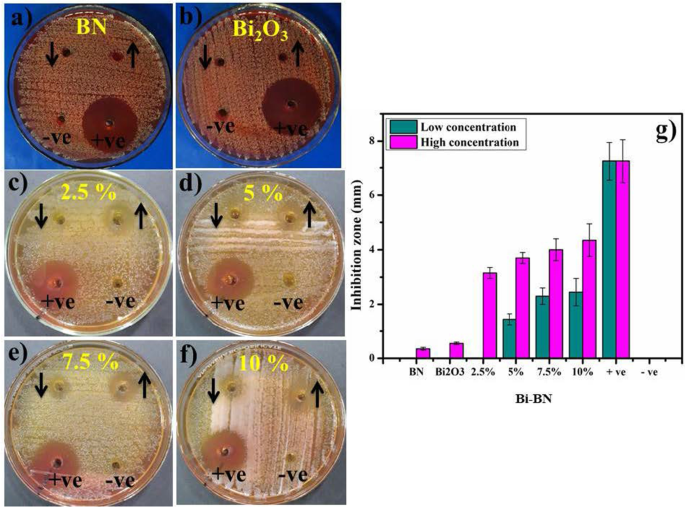
一 –g In-vitro antimicrobial efficiency of BN (a ) Bi2O3 (b ) BN nanosheets doped with various concentrations (2.5, 5, 7.5 and 10 wt%) of Bi against S.金黄色葡萄球菌 (c –f ) graphical presentation (g )
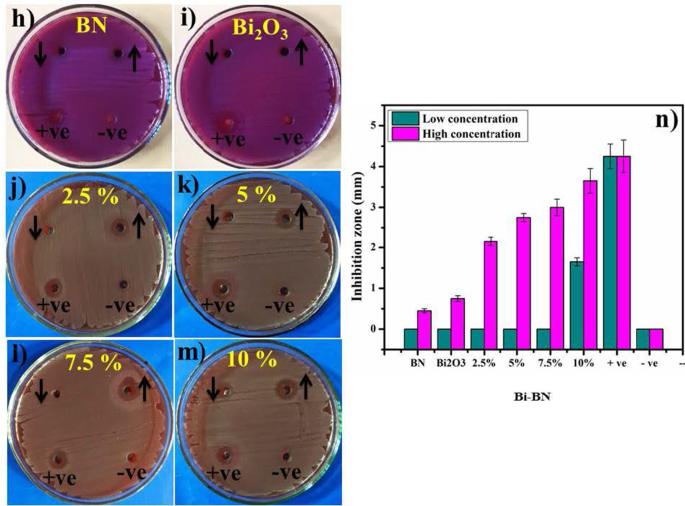
h –n In-vitro antimicrobial efficiency of BN (h ) Bi2O3 (i ) BN nanosheets doped with various concentrations (2.5, 5, 7.5 and 10 wt%) of Bi against E.大肠杆菌 (j –m ) graphical demonstration (n )
The oxidative stress fashioned by nanosheets depends upon its size, shape, and concentration. Antibacterial activity with inhibition zones (mm) raised with greater wt% doping of Bi on BN due to more cationic availability. Antibacterial activity depending on size and concentration exhibited inverse relation to doped NS size [2, 22, 80]. ROS generation is considered a major hazardous factor for the destruction of micropathogens [81]. Small-sized NS produce reactive oxygen species (ROS) that stay more real within bacteria membrane within implants ensuing extrusion of cytoplasmic contents and damaging bacterial DNA, proteins, and enzymes thus, killing bacteria as illustrated in Additional file 1:Fig. S7 (a) [80, 82]. Upon irradiation, NPs activate e − transfer from valence to conduction bands for reduction reactions by generating holes (h + ) which, ultimately transfer to valence band for oxidation [83, 84]. The reduction process generates O2 − . by reaction of e − with O2 [85]. The holes (h + ) via oxidation process generate OH through reaction with either e − from water (H2O) or hydroxyl ions (OH − ) [86]. The intense reactive oxygen radical species OH quickly reacts with micropathogens biomolecules i.e. proteins, carbohydrates, DNA, lipids and amino acids as shown in Additional file 1:Fig. S7 (a) [87]. Bismuth composites are famous for much effective antibacterial action coupled with low environmental toxicity [88]. Secondly, strong cationic interface of Bi +3 with negatively charged bacterial cell membrane parts grades in increased antibacterial action at high concentrations prompting bacteria collapse [2].
Enzyme catalyzing key steps of various biochemical reactions needed for bacterial survival represents attractive targets for antibiotic discovery. Molecular docking studies to predict inhibition tendency of nanoparticles against selected enzyme targets are of utmost importance for new antibiotic discovery. The mechanism of enzyme inhibition is depicted in Additional file 1:Fig. S7 (c) showing blockage of enzyme active site that hinder substrate access and disrupt catalytic activity of given enzyme target causing bacterial death.
Although extensive literature is reported over biological potential of nanomaterials particularly, bactericidal activity still clear mechanism of their action is not known. Nanomaterials show their antibacterial activity either through cell wall rapturing or may target key enzymes of various pathways that are essential for bacterial survival (see Additional file 1:Fig. S7) [80, 89]. Identifying their target is of worth importance and may contribute towards discovery of new antibiotics with a novel mode of action [90]. Here, enzyme targets of two well-known antibiotics i.e. Rifampicin (Nucleic acid synthesis) and Trimethoprim (Folate biosynthetic pathway) [91] have been selected to evaluate binding tendency, binding interaction pattern, and inhibitory mechanism of Bi-doped BN nanosheets behind their antibacterial activity.
In case of DHFR from E.coli , the best-docked conformation showed H-bonding interaction with Ile14 (2.68 Å) and Ile94 (2.27 Å) alongside metal-contact interaction with Tyr100 having binding score as − 11.971 kcal/mol (Fig. 10a). Similarly, H-bonding interaction with Thr46 (2.19 Å) and metal-contact with Leu20 was observed in case of DHFR from S.金黄色葡萄球菌 having binding score − 8.526 kcal/mol as shown in Fig. 10b.
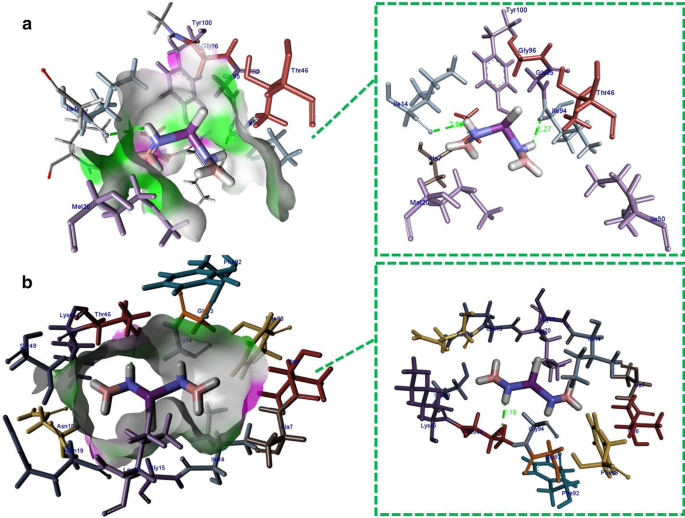
Binding interaction pattern of Bi-doped BN nanosheets with active site residues of dihydrofolate reductase from a E。大肠杆菌 和 b S。金黄色葡萄球菌
For DNA gyrase from E.coli , the best binding score observed was − 6.782 kcal/mol having H-bonding interaction with Asp73 (2.22 Å) as shown in Fig. 11a while in case of DNA gyrase from S.金黄色葡萄球菌 H-bonding interaction were observed with Asp81 (2.12 Å and 2.68 Å) alongside metal contact interaction with Ile175 having binding score − 7.819 kcal/mol (Fig. 11b).
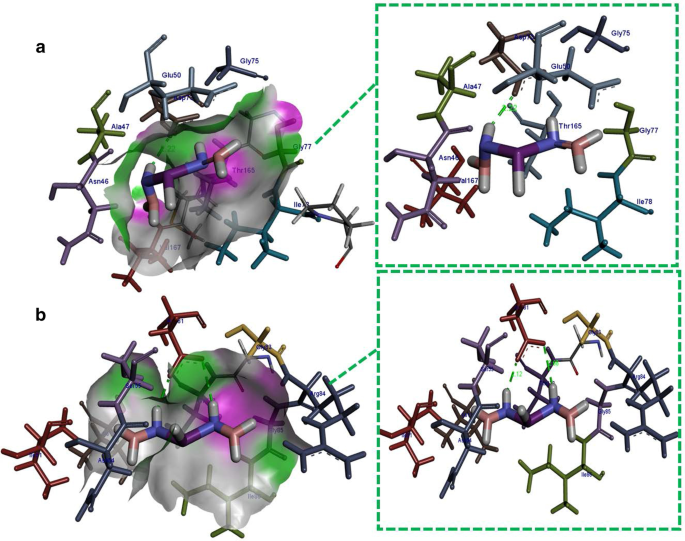
Binding interaction pattern of Bi-doped BN nanosheets with active site residues of DNA gyrase from (a) E。大肠杆菌 and (b) S。金黄色葡萄球菌
结论
BN nanosheets were successfully prepared through liquid-phase exfoliation of bulk BN while Bi was incorporated as dopant via hydrothermal approach. Various properties of synthesized material were studied using number of characterization approaches that are well harmonized with literature. XRD patterns indicated the presence of hexagonal phase of BN with peak shift to higher diffraction angle, which authenticates successful incorporation of dopant. FTIR spectra affirm the presence of in-plane B–N bending and out-of-plane B–N–B stretching vibrations, which corresponds to the presence of infrared active E 1u and A 2u modes of BN. The presence of luminescence band was affirmed through PL analysis whereas UV–Vis spectroscopy indicates the occurrence of absorption in near UV region. Morphological examinations were studied via FESEM and HR-TEM micrographs indicated sheet-like morphology with decoration of Bi over nanosheets, which signifies an effective doping procedure. Interlayer spacing estimated through HR-TEM images with the aid of Gatan digital micrograph software that corresponds well with XRD; while EDS spectra showed strong signals originating from both pure as well as dopant material. The optimization results from the first principle calculation reveal that Bi can be substituted and stable into BN nanosheets with different concentrations. Impurity bands due to Bi atoms introduce a sub-bandgap energy absorption in the electronic bandgap energy region which might increase the catalytic activity. Investigation of dye degradation via CA experiments resulted in an efficient and rapid process. Further pure and doped BN nanosheets serve as stable, reusable, and outstanding nanocatalyst for wastewater treatment. In addition, antimicrobial efficiency of doped BN nanosheets against S.金黄色葡萄球菌 和E。大肠杆菌 isolated directly from caprine mastitic milk resulted in significant quantitative values. In silico predictions against selected enzyme targets i.e. DHFR and DNA gyrase from E.大肠杆菌 和S。金黄色葡萄球菌 were in good agreement with in-vitro bactericidal activity thereby, opening a new horizon for the use of doped nanomaterials as potential agents for antimicrobial and CA procedures. Theoretical calculations are in good agreement with experimental values. Theoretical study indicates that substitutional doping of Bi with different concentrations is stable. Moreover, Bi doping led to various modifications in the electronic structures of BN nanosheets by inducing new localized gap states around the Fermi level. Finally, upon these results, it can be concluded that Bi-doped BN nanosheets is a suitable material to utilize in industrial wastewater applications, and antimicrobial treatment.
数据和材料的可用性
所有数据完全可用,不受限制。
缩写
- Bi:
-
铋
- BN:
-
氮化硼
- EDS:
-
能量色散X射线光谱
- FESEM:
-
场发射扫描电镜
- FTIR:
-
傅里叶变换红外光谱
- G+ve:
-
Gram-positive
- G–ve:
-
Gram-negative
- HR-TEM:
-
高分辨透射电子显微镜
- JCPDS:
-
粉末衍射标准联合委员会
- MA:
-
MacConkey agar
- MB:
-
亚甲蓝
- 纳米:
-
纳米
- PL:
-
光致发光
- UV-Vis:
-
紫外可见光谱
- XRD:
-
X射线衍射
纳米材料


